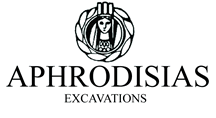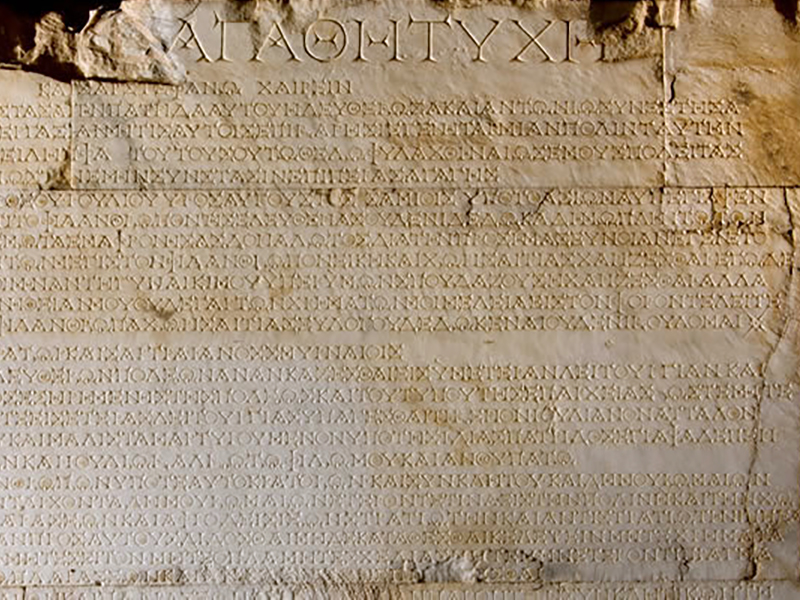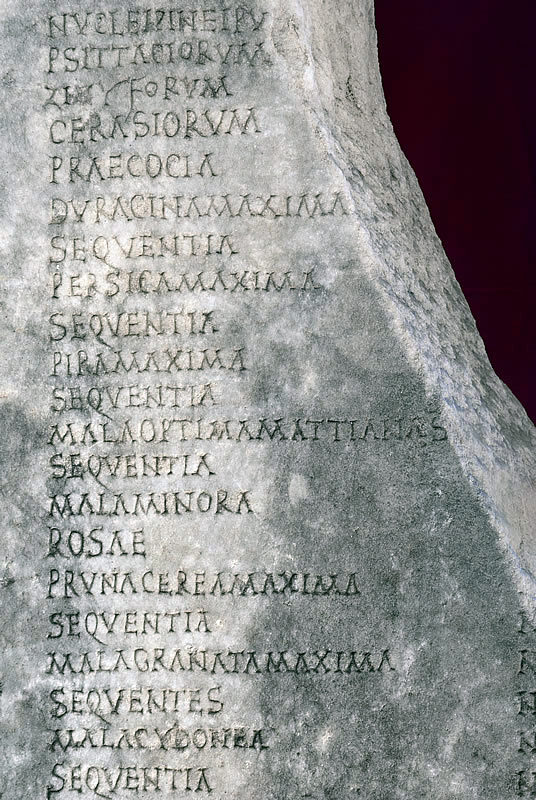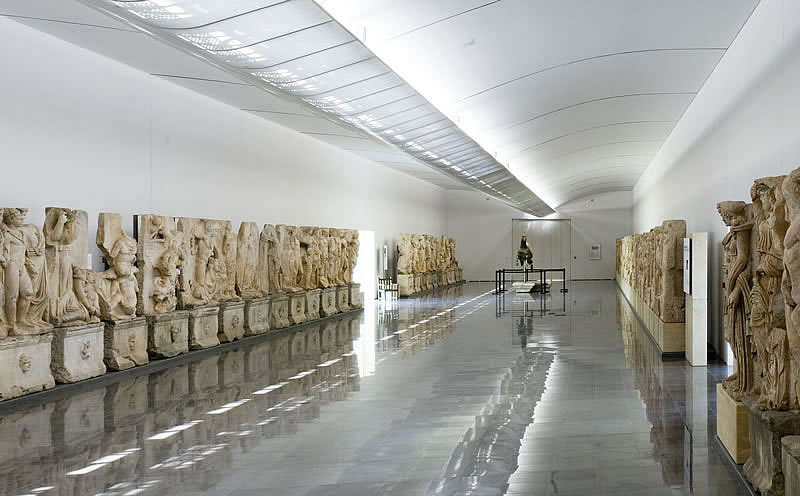Publications
Epigraphy
- Bonz, M.P. 1994 ‘The Jewish Donor Inscriptions from Aphrodisias: Are they both 3rd Century, and who are the Theosebeis?,’ Harvard Studies in Classical Philology, 281-299.
- Calder, W.M. and Cormack, J.M.R. 1962. Monuments from Lycaonia, the Pisido-Phrygian Border, Aphrodisias, Monumenta Asiae Minoris Antiqua 8, Manchester: Manchester University Press, 72-160.
- Carruba, O. 1970. ‘A Lydian Inscription from Aphrodisias in Caria,’ Journal of Hellenic Studies 90, 195-196.
- Chaniotis, A. 2002a. ‘The Jews of Aphrodisias: New Evidence and Old Problems,’ Scripta Classica Israelica 21, 209-242.
- Chaniotis, A. 2002b. ‘Zwischen Konfrontation und Interaktion: Christen, Juden und Heiden im Spätantiken Aphrodisas,’ in C. Ackermann and K.E. Müller (eds.), Patchwork: Dimensionen multikultureller Gesellschaften, Bielefeld, 83–128.
- Chaniotis, A. 2003. ‘Vom Erlebnis zum Mythos: Identitätskonstruktionen im kaiserzeitlichen Aphrodisias,’ in E. Schwertheim and E. Winter (eds.), Stadt und Stadtentwicklung in Kleinasien, Bonn: Asia Minor Studien 50, 69-84.
- Chaniotis, A. 2004a. ‘Epigraphic Evidence for the Philosopher Alexander of Aphrodisias,’ Bulletin of the Institute of Classical Studies 47, 79-81.
- Chaniotis, A. 2004b. ‘New inscriptions from Aphrodisias (1995-2001),’ American Journal of Archaeology 108, 2004, 377-416.
- Chaniotis, A. 2005. ‘Macht und Volk in den kaiserzeitlichen Inschriften von Aphrodisias,’ in G. Urso (ed.), Popolo e potere nel mondo antico : atti del convegno internazionale, Cividale del Friuli, 23-25 settembre 2004, Pisa: Convegni della Fondazione Niccolò Canussio 4, 47-61.
- Chaniotis, A. 2008a. ‘The Conversion of the Temple of Aphrodite at Aphrodisias in Context,’ in J. Hahn, S. Emmel & U. Gotter (eds.), From temple to church : destruction and renewal of local cultic topography in late antiquity, Leiden: Brill, 243-273.
- Chaniotis, A. 2008b. ‘Graffiti and social history at Aphrodisias,’ in R. R. R. Smith, and J. Lenaghan (eds.), Aphrodisias’tan Roma portreleri (Roman Portraits from Aphrodisias), Istanbul: Yapı Kredi Publishing, 200-215.
- Chaniotis, A. 2008c. ‘Twelve buildings in search of a location: unidentified buildings in the inscriptions of Aphrodisias, in C. Ratté, and R.R.R. Smith (eds.), Aphrodisias Papers 4: New Research on the City and its Monuments, Portsmouth, RI: Journal of Roman Archaeology Supplement 70, 61-78.
- Chaniotis, A. 2008d. ‘New Inscriptions from Late Antique Aphrodisias,’ Tekmeria 9, 2008, 219-232.
- Chaniotis, A. 2009. ‘Lament for a young man. A new epigram from Aphrodisias,’ in A. Martínez Fernández (ed.), Estudios de Epigrafía Griega, Santa Cruz de Tenerife : Universidad de La Laguna, 469-77.
- Chaniotis, A. 2010a. ‘Aphrodite’s Rivals: Devotion to Local and Other Gods at Aphrodisias,’ Cahiers du Centre Gustave Glotz 21, 235-48.
- Chaniotis, A. 2010b. ‘New evidence from Aphrodisias concerning the Rhodian occupation of Karia and the early history of Aphrodisias,’ in R. Van Bremen and J-M.Carbon (eds.), Hellenistic Karia, Talence : Ausonius, 455-66.
- Chaniotis, A. 2011. ‘Graffiti in Aphrodisias: images – texts – contexts,’ in J. A. Baird and C. Taylor (eds.), Ancient Graffiti in Context, London: Routledge, 191-207.
- Chaniotis, A. 2012. ‘Inscriptions’ in C. Ratté and P. D. De Staebler (edd.), Aphrodisias V. The Aphrodisias Regional Survey, Mainz: von Zabern, 347-66.
- Chaniotis, A. 2013a. ‘Roman Army in Aphrodisias’, Revue des Études Militaires Anciennes 6, 151-58.
- Chaniotis, A. 2013b. ‘Second Thoughts on Second Names in Aphrodisias,’ in R. Parker (ed), Personal Names in Ancient Anatolia, Oxford: Oxford University Press, 207-29.
- Chaniotis, A. 2014. ‘Das kaiserzeitliche Gymnasion in Aphrodisias,’ in P. Scholz and D. Wiegandt (eds.), Das kaiserzeitliche Gymnasion, Berlin.
- Chaniotis, A., and T. Fujii 2015. ‘A new fragment of Diocletian’s currency regulation from Aphrodisias’, Journal of Roman Studies 105, 227-33.
- Chaniotis, A. and Rojas, F. 2016. ‘A second Lydian inscription from Aphrodisias’ in R.R.R. Smith et al. (eds.), Aphrodisias Papers 5: Excavation and Research at Aphrodisias, 2006-2012, Portsmouth, RI: Journal of Roman Archaeology Supplement 103, 341-346
- Chaniotis, A. 2016a. ‘New epigraphic finds, 2006-9’ in R.R.R. Smith et al. (eds.), Aphrodisias Papers 5: Excavation and Research at Aphrodisias, 2006-2012, Portsmouth, RI: Journal of Roman Archaeology Supplement 103, 333-340.
- Chaniotis, A. 2016b. ‘Three men of letters in Aphrodisias’ in R.R.R. Smith et al. (eds.), Aphrodisias Papers 5: Excavation and Research at Aphrodisias, 2006-2012, Portsmouth, RI: Journal of Roman Archaeology Supplement 103, 347-352.
-
Chaniotis, A. 2016c. Habent sua fata inscriptiones. A mortar impression of an inscription from Aphrodisias. Budapest; Debrecen: Eötvös Lorand University ; University of Debrecen, 95-104.
- Chaniotis, A. 2016d. Pankrates: A Senior Statesman from Aphrodisias. Petropoli: Biblioteca Classica Petropolitana, 282-292.
- Chaniotis, A. 2016e. ‘The Age of a parthenos. A new Epitaph from Aphrodisias.’ Philia et al. (eds.), Vir Doctus Anatolicus. Studies in Memory of Sencer Şahin, 200-205.
- Chaniotis, A. 2017. ‘The age of a parthenos. A new epitaph from Aphrodisas’ Studies in Honour of Sencer Şahin. Sencer Şahin Anısına Yazılar. Istanbul: Philia Supplement 1, 200-205.
- Chaniotis, A., and P. De Staebler 2018. ‘Gladiators and Animals. New Pictorial Graffiti from Aphrodisias and their Contexts‘, Philia 4, 31-54.
- Chaniotis, A. 2018. ‘Alltagsskizzen aus Aphrodisias’ in P. Lohmann(ed.) Historische Graffiti als Quellen, Stuttgart: Steiner, 77-91.
- Chaniotis, A. 2019a. Aphrodisias: Tarihçe ve Toplum yak. MÖ 200 – yak. MS 230=Aphrodisias: History and Society ca. 200 BCE – ca. 230. Istanbul: Yapı Kredi Yayınları, 374-397.
- Chaniotis, A. 2019b. ‘Myon, a true ktistes: A new inscription from Aphrodisias and its context.’ in R. Raja (ed.) Visual Histories of the Classical World: Essays in Honour of R.R.R. Smith, Turnhout: Brepols, 449-458.
- Chaniotis, A. 2021. Momentaufnahmen aus kleinasien: Graffiti und Alltag im spätantiken Aphrodisias. Mainz: P. von Zabern, 15-18.
- Cormack, J.M.R., 1955. Notes on the History of the Inscribed Monuments of Aphrodisias, Reading: University of Reading.
- Cormack, J.M.R. 1964. ‘Inscriptions from Aphrodisias (found in 1893),’ Annual of the British School at Athens 59, 16-29.
- Drew-Bear, T. 1971. ‘Deux inscriptions a Aphrodisias,’ Zeitschrift für Papyrologie und Epigraphik 8, 285-288.
- Drew-Bear, T. 1972. ‘Deux decrets hellenistiques d’Asie Mineure,’ Bulletin de correspondance hellénique 96, 435-471.
- Erim, K.T. and Reynolds, J.M. 1969. ‘A Letter of Gordian III from Aphrodisias in Caria,’ Journal of Roman Studies 59, 56-58.
- Erim, K.T. and Reynolds, J. M. 1970. ‘The Copy of Diocletian’s Edict on Maximum Prices from Aphrodisias in Caria,’ Journal of Roman Studies 60, 120-141.
- Erim, K.T., Reynolds, J.M. and Crawford, M. 1971. ‘Diocletian’s Currency Reform. A New Inscription at Aphrodisias,’ Journal of Roman Studies 61, 171-177.
- Erim, K.T. and Reynolds, J. M. 1973. ‘The Aphrodisias Copy of Diocletian’s Edict on Maximum Prices,’ Journal of Roman Studies 63, 99-110.
- Erim, K. T. and Reynolds, J. M. 1989. ‘Sculptors of Aphrodisias in the inscriptions of the city,’ Festschrift für Jale İnan, Istanbul: Arkeoloji ve Sanat Yayınları, 517-538.
- Feissel, D. 1996. ‘Notes d’epigraphie chretienne (X),’ Bulletin Correspondance Hellénique 119, 375-389.
- Jones, C. P. 1997. ‘Epigrams from Hierapolis and Aphrodisias,’ Hermes 125, 203-314.
- Jones, C.P. and R.R.R. Smith, 1994. ‘Two inscribed monuments of Aphrodisias,’ Archäologischer Anzeiger, 455-472.
- Kokkinia, C. 2008. ‘Aphrodisias’s ‘rights of liberty’: diplomatic strategies and the Roman governor,’ in C. Ratté, and R.R.R. Smith (eds.), Aphrodisias Papers 4: New Research on the City and its Monuments. Portsmouth, RI: Journal of Roman Archaeology Supplement 70, 51-60.
- Kubinska, J. 1970. ‘Les tombeaux d’Aphrodisias d’après les inscriptions,’ Études et traveaux du centre d’archéologie mediterranéenne de l’académie polonaise des sciences 4, 114-18.
- Livrea, E. 1997. ‘I due Taziani di un inscrizione di Afrodisia,’ Zeitschrift für Papyrologie und Epigraphik 119, 43-49.
- Merkelbach, R. 1970. ‘Epigramm aus Aphrodisias,’ Zeitschrift für Papyrologie und Epigraphik 6, 132.
- Merkelbach, R. 1974a. ‘Nochmal zum Dekret für den Pankratiasten Kallikrates,’ Zeitschrift für Papyrologie und Epigraphik 13, 276.
- Merkelbach, R. 1974b. ‘Über ein ephesisches Dekret für einen Athleten aus Aphrodisias,’ Zeitschrift für Papyrologie und Epigraphik 14, 91-96.
- Paris, P. and Holleaux, M. 1885. ‘Inscriptions de Carie, I. Aphrodisias,’ Bulletin de correspondence hellénique 9, 324-348.
- Pont, A-V. 2008. ‘Évergètes bâttiseurs à Aphrodisias au Haut-Empire, in Athanasios D. Rizakis and Francesco Camia (eds.), Pathways to power : civic elites in the Eastern part of the Roman Empire : Proceedings of the International Workshop held at Athens, Scuola Archeologica Italiana di Atene, 19 December 2005, Athens: Scuola Archeologica Italiana di Atene, 181-208.
- Raggi, A. and P. Buongiorno, 2020. Il senatus consultum de Plarasensibus et Aphrodisiensibus del 39 a.c. Edizione, traduzione, e commento (Actus Senatus B. Band 7), Stuttgart: Steiner.
- Reinach, T. 1906. Inscriptions d’Aphrodisias, Revue des études grecques 19, 79-150, 205-298.
- Reynolds, J.M. 1973. ‘Aphrodisias, a Free and Federate City,’ Vestigia 17, 115-122.
- Reynolds, J.M. 1979. ‘The Aphrodisias Copy of Diocletian’s Edict on Maximum Prices,’ Zeitschrift für Papyrologie und Epigraphik 33, 46.
- Reynolds, J.M. 1980. ‘The origins and beginnings of imperial cult at Aphrodisias,’ Proceedings of the Cambridge Philological Society 206, 70-84.
- Reynolds, J.M. 1981. ‘New evidence for the imperial cult in Julio-Claudian Aphrodisias”, Zeitschrift für Papyrologie und Epigraphik 43, 317-327
- Reynolds, J. M. 1982. Aphrodisias and Rome: Documents from the Excavation of the Theatre at Aphrodisias Conducted by Professor Kenan T. Erim, Together with Some Related Texts. London: Journal of Roman Studies Monograph 1.
- Reynolds, J.M. 1986. ‘Further information on imperial cult at Aphrodisias,’ Studii Clasice 24, 109-17.
- Reynolds, J. M. 1990. ‘Inscriptions and the building of the Temple of Aphrodite,’ in C. Roueché and K. T. Erim (eds.), Aphrodisias Papers: Recent work on architecture and sculpture, Ann Arbor, MI: Journal of Roman Archaeology Supplement 1, 37-40.
- Reynolds, J. M. 1991. ‘Epigraphic evidence for the construction of the theatre: 1st c. B.C. to mid 3rd c. A.D.,’ in R.R.R. Smith and Erim, K.T. (eds.), Aphrodisias Papers 2: the theatre, a sculptor’s workshop, philosophers, and coin-types, Ann Arbor, MI: Journal of Roman Archaeology Supplement 2, 15-28.
- Reynolds, J.M. 1994. ‘L. Egnatius Victor Lollianus and Carian Aphrodisias,’ in Y. Le Bohec, (ed), L’Afrique, le Gaule, la religion à l’epoque romaine : Mélanges à la mémoire de Marcel Le Glay, Brussels: Latomus. 675-680.
- Reynolds, J. M. 1995a. ‘Diocletian’s Prices Edict: New fragments of the Copy at Aphrodisias,’ in R. Frei-Stolba and M.A. Speidel (eds.), Römische Inschriften — Neufunde, Neulesungen und Neuinterpretation, Festschrift für Hans Lieb. Basel: Friedrich Reinhardt, 17-28.
- Reynolds, J. M. 1995b. ‘The linen-market of Aphrodisias in Caria,’ in Arculiana, Recueil d’hommages offerts à H. Bögli, Avenches: LAOTT, 523-528.
- Reynolds, J. M. 1995c. ‘The dedication of a Bath Building at Carian Aphrodisias,’ Studia in honorem Georgii Mihailov, Sofia: Sofia University, 397-402.
- Reynolds, J. M. 1996a. ‘Honouring benefactors at Aphrodisias: a new inscription,’ in C. Roueché and R. R. R. Smith (eds.), Aphrodisias Papers 3: The setting and quarries, mythological and other sculptural decoration, architectural development, Portico of Tiberius, and Tetrapylon, Ann Arbor, MI: Journal of Roman Archaeology Supplement 20, 121-126.
- Reynolds, J.M. 1996b. ‘Ruler-cult at Aphrodisias in the late Republic and under the Julio-Claudian Emperors,’ in A. Small (ed.), Subject and Ruler: the Cult of the Ruling Power in Classical Antiquity. Ann Arbor, MI: Journal of Roman Archaeology Supplement 17, 41-50.
- Reynolds, J. M. 1997. ‘Sculpture in Bronze: an inscription from Aphrodisias,’ Archeologia Classica 49, 423-428.
- Reynolds, J. M. 1998. ‘An Ordinary Aphrodisian Family: The Message of a Stone,’ in G. Schmeling (ed), Qui Miscuit Utile Dulci: Festschrift Essays for Paul Lachlan MacKendrick, Wauconda, IL: Bolchazy-Carducci Publishers, 287-296.
- Reynolds, J. M. 1999. ‘The first known Aphrodisian to hold a procuratorship,’ in P. Scherrer et al. (eds.), Steine und Wege. Festschrift für Dieter Knibbe zum 65. Geburtstag, Vienna: Österreichisches Archäologisches Institut, 327-334.
- Reynolds, J. M. 2002. ‘A New Inscription from Carian Aphrodisias,’ in P. McKechnie (ed.), Thinking Like a Lawyer : essays on legal history and general history for John Crook on his eightieth birthday, Leiden: Brill, 247-251.
- Reynolds, J. M. 2008a. ‘The inscriptions of the Basilica,’ in C. Ratté, and R.R.R. Smith (eds.), Aphrodisias Papers 4: New Research on the City and its Monuments. Portsmouth, RI: Journal of Roman Archaeology Supplement 70, 131-143.
- Reynolds, J. M. 2008b. ‘Inscriptions from the Bouleuterion/Odeion,’ in C. Ratté, and R.R.R. Smith (eds.), Aphrodisias Papers 4: New Research on the City and its Monuments. Portsmouth, RI: Journal of Roman Archaeology Supplement 70, 169-189.
- Reynolds, J.M. and Roueché, C. 1992. ‘The Funeral of Tatia Attalis of Aphrodisias,’ Ktema 17, 1992, 153-160.
- Reynolds, J. M. and Roueché, C. 2007. ‘The inscriptions,’ in F. Işık, Girlandensarkophage aus Aphrodisias, Sarkophag-Studien 5.
- Reynolds, J. M., Souris, G. et al. 2000. ‘New Letters from Hadrian to Aphrodisias: trials, taxes, gladiators and an aqueduct,’ Journal of Roman Archaeology 13, 5-20.
- Reynolds, J. M. and Tannenbaum, R. 1987. Jews and God-Fearers at Aphrodisias: Greek Inscriptions with Commentary. Cambridge Philological Supplement 12.
- Robert, L. 1937. Inscriptions d’Aphrodisias, Etudes Anatoliennes, Amsterdam, 312-19.
- Robert, L. 1939. Inscriptions grecques d’Asie Mineure, II. Inscriptions d’Aphrodisias, Anatolian Studies Presented to W. H. Buckler, Manchester, 227-248 (repr. in L. Robert, Opera Minora Selecta 6, 1966, 611-632).
- Robert, L. 1948. Epigrammes d’Aphrodisias, Hellenica 4, 127-135.
- Robert, L. and J. 1954. La Carie II. Le plateau de Tabai.
- Roueché, C. 1979. ‘A New Inscription from Aphrodisias and the Title pater tes poleos,’ Greek, Roman, and Byzantine Studies 20, 173-185.
- Rouché, C. 1981. ‘Rome, Asia, and Aphrodisias in the third Century,’ Journal of Roman Studies 71, 103-20.
- Roueché, C. 1991. ‘Inscriptions and the later history of the theatre,’ in R.R.R. Smith. and Erim, K.T. (eds.), Aphrodisias Papers 2: the theatre, a sculptor’s workshop, philosophers, and coin-types, Ann Arbor, MI: Journal of Roman Archaeology Supplement 2, 99-108.
- Roueché, C. 1992. ‘Les spectacles dans la cité romaine et post romaine,’ Cahiers Glotz 3, 1992, 157-161.
- Roueché, C. 1993. Performers and Partisans at Aphrodisias in the Roman and Late Roman Periods. London: Journal of Roman Studies Monograph 6.
- Roueché, C. 1995. ‘Aurarii in the auditorium,’ Zeitschrift für Papyrologie und Epigraphik 105, 37-50.
- Roueché, C. 1996. ‘A new governor of Caria-Phrygia: P. Aelius Septimius Mannus,’ in A. Chastagnol, S. Demougin and C. Lepelley (eds.), Splendidissima Civitas: études d’histoire romaine en hommage à Francois Jacques, Paris, 231-239.
- Roueché, C. 1999. ‘Looking for Late Antique Ceremonial: Ephesos and Aphrodisias,’ in F Krizinger (ed.), Ephesos, 100 Jahre Osterreichische Forschungen, Akten des Symposions Wien 1995, Vienna: Archaologische Forschungen 1, 161-168.
- Roueché, C. 2004. Aphrodisias in Late Antiquity, electronic second edition, London.
- Roueché, C. 2007a. ‘Gameboards and pavement markings at Aphrodisias’ in I. Finkel (ed.), Ancient Board Games in Perspective: Papers from the 1990 British Museum Colloquium, with additional papers, London.
- Roueché, C. 2007b. ‘From Aphrodisias to Stauropolis’ in J. Drinkwater and R. S. Salway (eds.), Wolf Liebeschuetz reflected : essays presented by colleagues, friends, & pupils, London, 183-192.
- Roueché, C. 2011. ‘Seeing statues,’ in F. D’Andria and I. Romeo (eds.), Roman Sculpture in Asia Minor. Portsmouth, RI: Journal of Roman Archaeology Supplement 80, 91-100.
- Roueché, C. and Erim, K.T. 1982. ‘Sculptors from Aphrodisias: Some New Inscriptions,’ Papers of the British School at Rome 50, 102-115.
- Sevcenko, I. 1967. ‘An Epigram Honoring the Praeses of Caria, Oikoumenios,’ Dumbarton Oaks Papers 21, 285-286.
- Sevcenko, I. 1968. ‘A Late Epigram and the so-called Elder Magistrate from Aphrodisias,’ in Synthronon: Art et archeologie de la fin de l’Antiquite et du Moyen age, Recueil d’etudes par Andre Grabar et un groupe de ses disciples, Paris: Librairie C. Klincksieck, 29-41.
- Sharples, R. W. 2006. ‘Implications of the new Alexander of Aphrodisias inscription,’ Bulletin of the Institute of Classical Studies, 47-56.
- Schürre, D. 2011. ‘Zur enigmatischen Inschrift von Aphrodisias,’ Kadmos 50, 161–168.
- Smith, R.R.R. and Chaniotis, A. 2016. ‘Eleven new sarcophagi, mostly inscribed’ in R.R.R. Smith et al. (eds.), Aphrodisias Papers 5: Excavation and Research at Aphrodisias, 2006-2012, Portsmouth, RI: Journal of Roman Archaeology Supplement 103, 303-324.
- Van Bremen, R. 2010. ‘Adrastos at Aphrodisias,’ in R.W.V. Catling and F. Marchand (eds.), Onomatologos: Studies in Greek Personal Names Presented to Elaine Matthews Oxford, 440-455.
- Wieling, H.J. 1974. ‘Eine neuentdeckte Inschrift Gordians III und ihre Bedeutung für das Verständnis der Constitutio Anoniniana,’ Zeitschrift der Savigny-Stiftung für Rechtsgeschichte / Zeitschrift für Rechtsgeschichte 91, 364-374.







